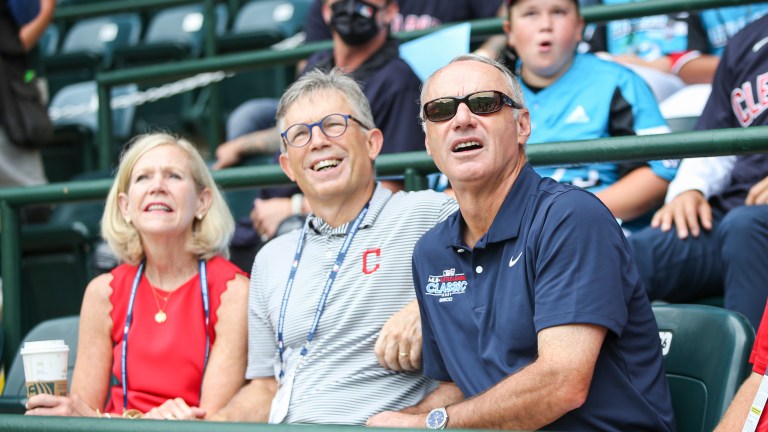The Phony Proposal By MLB Owners Will Not Address Competitive Balance
Don't fall for the show from MLB owners. This "Payroll Floor" proposal is a sham.

The MLB owners want you to believe they are serious about their latest “proposal” to the Players Association. They reportedly are willing to implement a salary floor requiring all MLB teams to operate with a minimum $100 million payroll. To get this done, the players would have to accept luxury taxes imposed on MLB payrolls of $180 million or higher. The owners know that the players will reject this as an attempt to limit spending by high payroll or high revenue teams. In the meantime, the owners can claim that they did their best to help promote more “competitive balance” in Major League Baseball. Then the owners will proceed with their real agenda: to push for a revenue plan that will funnel less money to the players and more to the owners.
As an example, consider that the current proposal would tax payrolls above $180 million, while creating a payroll floor of $100 million. As payrolls currently stand, this structure would tax a combined $259 million of team payroll over the $180 million figure, while raising payrolls by only $145 million for teams who are below the $100 million payroll floor (these figures are based on 2021 payrolls at the start of the season, see Marc Normandin, Baseball Prospectus, August 20, 2021).
What this would mean is top payroll teams would be discouraged from spending more money (a modified version of a salary cap). Meanwhile, the amount of money spent by teams required to boost their payroll would not increase their payrolls by anywhere near the same extent. The bottom line is: more revenues would go to owners at the expense of players. This would continue the trend of the past decade as owners have pocketed a rising percentage of MLB revenues (see my previous article for Just Baseball on this trend).
Many fans will instinctively support this bargaining maneuver by the owners. They will see the $100 million payroll floor as addressing a serious issue of competitive imbalance. On this point, the Players Association would agree, as would anyone that has seriously studied payroll disparities in baseball. In some cases, lower payroll teams are spending less money now than they were decades ago. As Marc Normandin has recently noted, the Cleveland Indians opening day roster for this season totaled just under $50 million, compared to $93.4 million in 2001. The stagnation of payrolls among the lower revenue teams is a problem that needs to be addressed.
However, there are better ways to address this problem than implementing artificial ceilings on MLB payrolls. The ceilings like luxury taxes or a salary cap would not necessarily help MLB with its competitive balance issues. The most comprehensive academic study, which was recently completed, compares competitive balance across all four major U.S. sports leagues. The study concludes that MLB has had the best competitive balance of all the sports leagues for decades, followed by the NHL (a close second) and the NFL and NBA. The NFL trails the MLB in aggregate competitive balance measurements despite the NFL’s hard salary cap, and the NBA is less competitive than MLB despite the league’s soft salary cap.
In short, MLB’s lack of a salary cap has not made the sport less competitive than others. Still, there are legitimate concerns about reduced competitiveness in the league, especially given the propensity of MLB teams to “tank” or to keep their payrolls low for lengthy time periods. The way to address this problem is by changing the current MLB revenue distribution formula. In the current collective bargaining agreement, 48% of MLB local revenues are shared among all teams, with about 6% of local revenues directly transferring money from higher to lower revenue clubs. At the margins, this makes a difference. For example, the Yankees share approximately 20 percent of their local revenues with lower revenue/lower market clubs, and teams like Tampa and Miami increase their local revenues by 50 percent as a result of this re-distribution (Forbes 2019).
Revenue sharing is necessary in all sports to maintain competitive balance. The best period of competitive balance in baseball was during the 1980s and early 1990s, when a wider range of teams competed for the playoffs and there were fewer gaps between the best and the worst teams in the sport. A key to explaining this period, which I refer to as the “golden age of competitive balance” in my 2006 book, is the elevated importance of national television contracts during this time. National TV revenue was evenly distributed among MLB teams, compared with local sources of revenues, and the fact that local sources of revenue were more stable back then than they are now.
After the late 1990s and early 2000s, when local media deals started generating significantly larger revenue streams for teams in large markets, MLB and the Players Association negotiated deals to facilitate a distribution of some of this money. This has helped improve competitive balance, but it’s not been enough.
For example, while 48% of local revenues are distributed evenly around the league, only about 6% is directly re-distributed from large revenue to small revenue teams. That figure should increase, so that more money is going to lower-revenue markets. After all, large revenue markets are generating that revenue by playing in a large market, which restricts the entry of additional teams to that market. And the only reason large-market teams make that money is because they play in a league whose success is dependent on a certain level of competitive balance. Below is a table documenting the impact of revenue sharing on national and local revenues of each MLB team, after the 2019 season.
TV Contract Revenue by Team (2019)
The current revenue sharing plan transfers a considerable amount of local television revenues to lower revenue teams, although it could and should be better. The table shows the amount of local television money (first column) a team received in 2019 prior to revenue sharing, then the impact of revenue sharing on that figure (second column), the distribution of national television revenue to each team (third column) and the final net television revenue per team (fourth column).
Improving upon this existing distribution of local revenues is the best solution for addressing competitive balance issues. If more money does go to low-revenue teams, or if a payroll floor is established in the next collective bargaining agreement, there is no need to connect that to a stricter luxury tax formula, or a soft version of a salary cap or, worst of all, a real salary cap. These methods of reducing payroll take money out of the players’ pockets and put it in the owners. This approach does not address competitive balance. Instead, adjusting the existing distribution of local revenues (as shown above) is the best way to go. Low payroll teams should be getting disproportionate revenues from high payroll teams. When revenues are more equally distributed within the sport, competitive balance is greater. But luxury taxes on high payrolls or salary caps are not necessary for this. Increased percentages of local revenues distributed from the top teams to the bottom teams is sufficient.
What will not work, however, is continuing a current system that allows lower payroll teams to pocket the shared local revenues without reinvesting this money into their major league payroll. There needs to be an enforcement mechanism and an incentive system that ensures that revenue sharing will be used to increase payrolls, not to tank. This could involve a modest payroll floor, which could prove very helpful. An even better way to address this is to provide incentives to lower revenue teams to win more games. This should include rewarding lower revenue teams that have higher winning percentages by tying revenue distribution to a gradation based on winning percentages. At the very least, if lower revenue teams want to continue to receive the same percentage of local revenues from high revenue teams, they should be required to show improvement over time in winning percentage.
Baseball fans should not be fooled by the owners’ theatrical gestures. The owners are not providing solutions to competitive balance issues with their latest propaganda masked as a “proposal.” In fact, baseball has fewer competitive balance problems than we are led to believe. Competitive balance problems in baseball were far worse in the 1940s, 1950s and early 1960s before free agency. Competitive balance is actually better now than during these periods that are often referenced as the “golden age,” which were not so golden for most franchises not named the Yankees. In addition, as the most sophisticated statistical studies have shown, baseball has better competitive balance than the other major sports leagues. What the owners are trying to do is to take money from the players and put it in their pockets. That’s the main objective in collective bargaining. For me, I would rather more money go to the athletes who play the game. Competitive balance can be addressed much better and more directly by adjusting the existing distribution of local revenues, instead of taking money from the players.

